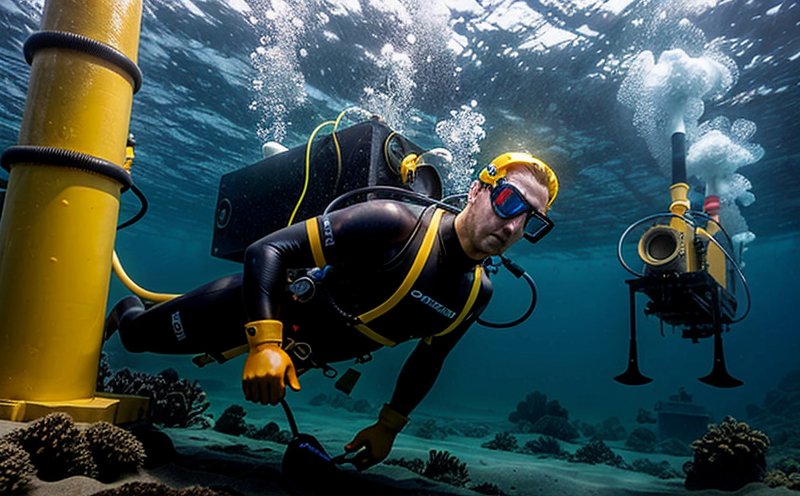DNVGL-OS-C401 NDT Testing of Subsea Welds
The DNVGL-OS-C401 standard is a comprehensive set of guidelines designed to ensure the integrity and safety of subsea welds, which are critical components in offshore oil and gas installations. This service focuses on Non-Destructive Testing (NDT) methodologies as specified by this standard, ensuring that welds meet stringent quality requirements before they are submerged into marine environments.
NDT testing plays a pivotal role in the assessment of structural integrity without causing damage to the components being evaluated. For subsea equipment, where corrosion and pressure can be significant challenges, NDT is essential for detecting flaws such as cracks, porosity, and other defects that could lead to catastrophic failures under water.
The standard DNVGL-OS-C401 outlines specific procedures for magnetic particle inspection (MPI), radiographic examination (RT), ultrasonic testing (UT), and visual inspection (VT) of subsea welds. Each method has its own strengths, and the choice of which to apply depends on the specific requirements of the project.
For instance, MPI is effective in detecting surface-breaking defects such as cracks or pores, while RT provides a detailed view of internal defects. UT can measure thickness variations and detect subsurface flaws, whereas VT ensures that the weld meets visual quality standards.
The testing process begins with thorough preparation of the weld to ensure accurate results. This includes cleaning the area around the weld to remove any dirt or debris that could interfere with the test. The specimen is then subjected to one or more NDT methods as per DNVGL-OS-C401, depending on the requirements and the specific nature of the weld.
The use of advanced instrumentation ensures precision in testing. For MPI, specialized equipment is used to apply magnetic particles over the surface of the weld, which are then inspected for indications of flaws. In RT, high-energy X-rays or gamma rays penetrate through the weld, creating an image that can be analyzed for defects. UT employs ultrasonic waves to generate a reflection pattern from within the material, and VT uses visual examination tools.
Once the testing is complete, detailed reports are generated summarizing the findings of each NDT method applied. These reports serve as critical documentation for compliance with DNVGL-OS-C401 and help in making informed decisions regarding the safety and reliability of subsea equipment.
The importance of this service cannot be overstated. Offshore platforms, pipelines, and other subsea structures are exposed to harsh marine environments that can lead to corrosion, fatigue, and other forms of degradation. Ensuring that all welds meet the stringent requirements set by DNVGL-OS-C401 is crucial for maintaining operational safety and preventing costly failures.
Our laboratory adheres strictly to this standard, ensuring that every test conducted aligns with its guidelines. This commitment to quality and compliance helps our clients achieve peace of mind knowing their equipment meets the highest international standards.
Applied Standards
- DNVGL-OS-C401 for Non-Destructive Testing (NDT) of Subsea Welds
- ISO 9712:2012, Non-destructive testing – Qualification and certification of non-destructive testing personnel
- AWS D1.1/D1.2, American Welding Society’s welding standards for structural welds in the oil and gas industry
The application of these standards ensures that our NDT testing practices are consistent with international best practices. By adhering to these guidelines, we provide reliable and accurate results that can be trusted by clients.
Quality and Reliability Assurance
- All personnel involved in the testing process undergo rigorous training and certification according to ISO 9712:2012 standards.
- Our laboratory is equipped with state-of-the-art equipment that meets or exceeds international standards, ensuring precise and reliable test results.
- We maintain a comprehensive quality management system that complies with ISO 9001:2015 to ensure consistent high-quality performance in all our services.
- Regular calibration of instruments is performed by qualified technicians to guarantee accuracy and reliability.
The combination of these measures ensures that the tests conducted are not only accurate but also reproducible, providing a robust foundation for decision-making based on test results. Our clients can trust in the integrity and precision of our testing services.
Environmental and Sustainability Contributions
In addition to ensuring the quality and safety of subsea equipment, we are committed to environmental stewardship. By adhering strictly to DNVGL-OS-C401 standards, we contribute to minimizing the risk of accidents that could lead to oil spills or other environmental hazards.
Our laboratory practices sustainable operations by optimizing resource use, reducing waste, and implementing energy-efficient measures where possible. This commitment extends beyond our testing services into all aspects of our business operations.





